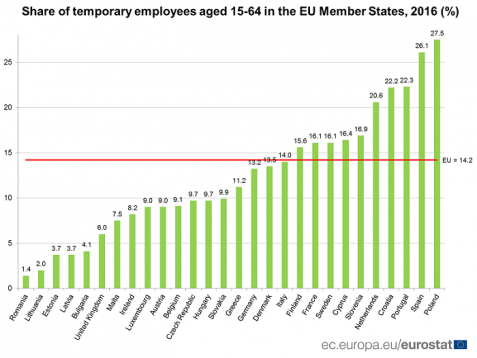 Romania marks one more indicator where it ranks the last in the European Union, namely the share of workers with a temporary employment relationship.
Romania marks one more indicator where it ranks the last in the European Union, namely the share of workers with a temporary employment relationship.
The level of 1.4% announced by Eurostat for 2016 is ten times lower than the EU average, of 14.2%, and nearly twenty times below the size of the country that is closest to us in terms of size and level of economic development, Poland (27.5%).
 The problem is not that we are below the BELL group consisting of the Baltic countries and Bulgaria (a neighbour and a colleague in the same EU wave of enlargement, where the percentage of temporary employees is triple), but the fact that we are right on the opposite side to Poland. This is, in many ways, our development pattern and the reference for the way of narrowing the gaps between us and the West.
The problem is not that we are below the BELL group consisting of the Baltic countries and Bulgaria (a neighbour and a colleague in the same EU wave of enlargement, where the percentage of temporary employees is triple), but the fact that we are right on the opposite side to Poland. This is, in many ways, our development pattern and the reference for the way of narrowing the gaps between us and the West.
In fact, the Poles have intensively used this method of increasing the employment to solve the problem of an unemployment well above the European average and to streamline a labour market facing the challenges of relatively rapid changes in the occupations and the relation between the supply and demand.
By contrast, the rather pronounced rigidity of the labour market in our country is a factor that discourages employers’ abuses, but diminishes the development dynamics of businesses, particularly in the micro-enterprises and SMEs segment.
Figures clearly indicate that we are outside the European practices in the field and offers an important point to be solved in the matter of real convergence.
The fact that the main driver, Germany, is only one percentage point below the EU average at this indicator (13.2%) and the other Romania’s major European partners are very close to this average, with the Latin sister Italy at 14% and France at 16.1%, should be a cause for reflection for us.
Especially that former colleagues from the socialist bloc have adjusted their practice in the field and got just a stone’s throw from the 10% threshold (Hungary and the Czech Republic).
The newly arrived Croatia reached 22.2% and all these countries, along with Poland, coincidence or not, have a similar free-floating national currency, different from the rigidity of the eurozone system (which the Baltic countries have joined, while Bulgarians already mention the amounts in euro on most receipts issued in stores).
Implications of reaching employment target set for 2020
Bringing the indicator of temporary employment to a level close to the EU countries that are in the same category but somewhat more advanced on the path of real convergence would also solve the issue of reaching the employment of 70% at national level, foreseen in the Europe 2020 strategy.
We are currently on a growth trend, at 66.3%, according to INS data for 2016, but we are unlikely to reach our target unless we do something in the matter of temporary employment.
Last year, 212,000 people were registered with part-time work relationships who were willing to work for more hours, being considered under-employed. They accounted for 2.4% of the active population, 2.5% of the employed population and 29.3% of the total number of people working part-time.
Of the inactive population, another 345,000 people were available to start working but did not seek employment. Significant for the gap to the 2020 target, they accounted for 3.8% of the active population. Developing programs for temporary employment would mobilize this potential workforce that remains unused.
Last, but not least, we notice our presence in the minority of countries where the share of women with temporary employment is much lower than that of men. In 18 EU countries (including all Western countries, except for Portugal and Germany, where gender equality is also seen in the area of work), the share of men working on a fixed-term basis is below that of women.
In our country, the percentage is the most unbalanced towards the male workforce (+ 70%), with only 1% of women in temporary employment. This suggests that the offer should be directed to the female segment if we are willing to get close to the European practice.
Only in Latvia we can see such a discrepancy (64%) but at a rate of 2.8% representing the proportion of women in temporary employment. That is, while Lithuania and Bulgaria have dropped below 30% and Estonia is moving towards 10%. That is the level where Poland or Slovakia also stand. While in the Czech Republic (11.6% compared to 8.1%), Hungary (10.2% compared to 9.4%) or Croatia (22.4% compared to 21.9%), the „score” is higher for the female workforce.









